Between
Bodies :Tijuana, July - September 2009
An interactive sound installation by Nina Waisman
FILE Festival, São Paulo, Brasil, FIESP/SESI Galleries
The best video documentation of this piece is of the Tijuana version (which has the same sound) and that can be found here:
Between Bodies,
video (4 minutes)
videoography: Patricia Montoya
But if you want to get a feel for the FILE version, here's a slightly sea-sick p.o.v. perspective, shot while installing the piece - apologies, I had not had much sleep! (note: the piece here is not yet cleaned up and the title for the piece wasn't complete on the wall - it became Between Bodies/Tijuana):
Betweeen Bodies in São Paulo, video (4 minutes)
Links to FILE site and other coverage:
http://www.file.org.br/
http://www.file.org.br/file2009/press_sp/
Some video coverage of installations at FILE:
http://www.youtube.com/watch?v=tU0Je_abR1k&feature=player_embedded (between bodies about 1:15 into this video)
And here are links to articles on the piece as shown in Tijuana:
Projecto
Civico Review on LatinArt.com
Make
Some Noise on San Diego CityBeat
Description
Between Bodies: Tijuana connects visitors’ actions to bodily energies circulating throughout Tijuana, making visceral our links to the vast network of human agency at work in the city. Products assembled at great human cost in Tijuana are sold worldwide, yet media hype would suggest our only connection to the city is through fear. We ingest media’s relentless feed of drug-related crimes; deliciously terrified, most stay away from the city, effecting a growing blockade. This lack of full representation of Tijuana’s civic life also short-circuits any social actions a richer portrayal might engender. The damaging cycle of media-fueled isolation is not unique to Tijuana.
If we are living in an attention economy, visitors’ movements in Between Bodies trigger sonic advertisements for the civic energy animating Tijuana. But these advertisements require you to supply your bodily energy to the exchange. The installation samples everyday work and play sound-gestures, recorded throughout the city. These sound-gestures are triggered and changed by visitors’ natural movements through the piece. Pitch, speed, volume and layering of sounds are modulated in real time, in relation to a visitor’s actions and proximity to sensors hung in a space. The visitor’s body becomes a tuning instrument, a transducer of others’ bodily energies. Ideally this transduction is not a one-way street. To explore the sound of another’s body requires one to listen to its rhythms, to internalize them in some way. A bodily understanding is hoped for.
The piece opens with sounds of labor (hammering, filing, typing, etc) to create a common-denominator of bodily and sonic experiences heard throughout Tijuana but also most anywhere in the world, sounds of bodily-gestures possibly engaged in by many visitors. A gestural dialog is set up between museum visitors and Tijuanenses, a dialog not dependent on knowledge of the city, thus one that might open the city to those who only know it through sensational reporting. The piece ends with sounds of surveillance, similarly heard worldwide.
In between, and woven throughout, are a range of broadly recognizable yet localizing sound-gestures, increasing in number as one advances through the piece. The piece can become an almost-musical dérive, connecting visitors to sonic bodies encountered throughout Tijuana. The sensing body’s role as Theremin, tuning a city, is here technologically enhanced.
Many Tijuanenses have a personal history with the sonic gestures heard in the piece, further elaborating the gestural-sonic dialogues they experience. While the piece may seem to offer non-residents a purely virtual tour of Tijuana, there is a potential for “gestural mirroring” in the work, complicating pure tourism. Neurologists have found that hearing the sound of another body performing an action can lead us to experience this same action in the brain and muscles. We don’t enact the gesture but nerve-clusters for producing the action fire, and muscles are primed to act. Neurologists link this mirroring system to a survival-driven need for empathic skills – when I hear you do something, I experience your state, and can sense viscerally how we might next interact.
Meanwhile, Rodolfo Llinas (NYU Neurosciences Chair) explains that our learned gestural skills - walking, typing, etc - play in our brains, even when we don’t move. Not all play at once, but a few play together at a time, randomly. Llinas’ research finds that the overlaying of these gestural tapes is the source of creative thought! New logics arise from interference between re-played memories of our motor-based actions. A new tech-gesture, then, is not a small thing.
To put this all together, hearing sounds of recorded bodies performing actions can lead listeners to "mirror" the heard gestures. These mirrored gestures, overlaid with whatever gestural tapes are already playing in a listener’s brain, can lead to new, affiliated logics. Adding to this common, gestural pile-up, visitors to my installations employ new tech-controlling gestures to manipulate gestural sounds heard in the space. This logic-forming, gesturally mashed-up medium is worth considering, given our increasing use of physical computing devices, surveillance systems, and mediated sound. My work asks experientially: how might tech-inflected gestures shape the logic of our relationships with bodies and systems we connect to.
Project Credits for Between Bodies:
Interactive Sound Installation: Nina Waisman
PD programming: Marius Schebella
Guides/Translators in Tijuana: Jenny Donovan & Ingrid Hernández
Special Thanks To:
Paula Perissinotto, Ricardo Barreto, Stella Tedesco Bertaso, Cicero Da Silva, Jane de Almeida, Eliane Weizmann, Fabiana Krepell, Anna Mauger, Samuel Rodrigues and Rafael Cardoso in São Paulo; Lucía Sanromán and Carmen Cuenca for generous support at CECUT; Pierre Galaud who selflessly offered his fabulous brains and body along the whole path of this project.
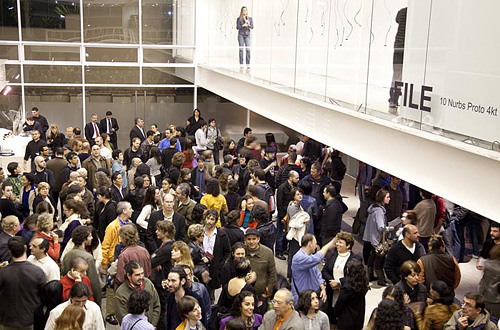
photo:
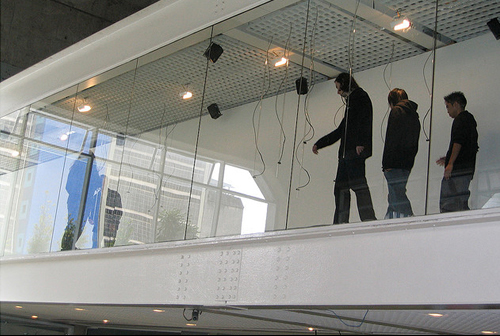
photo:
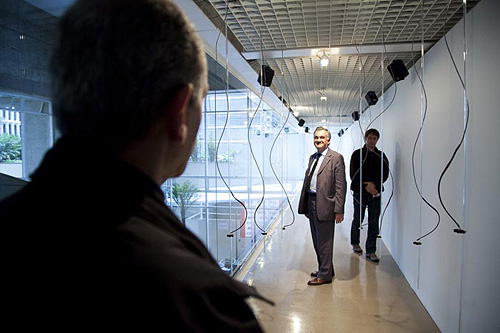
Juca Ferreira, the Minister of Culture, checks out the piece. photo:
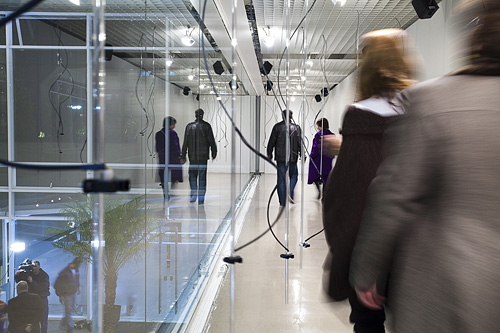
photo:
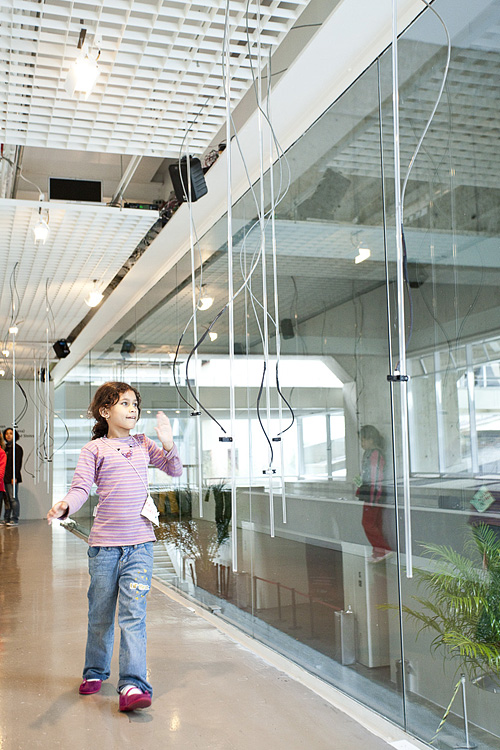
photo: